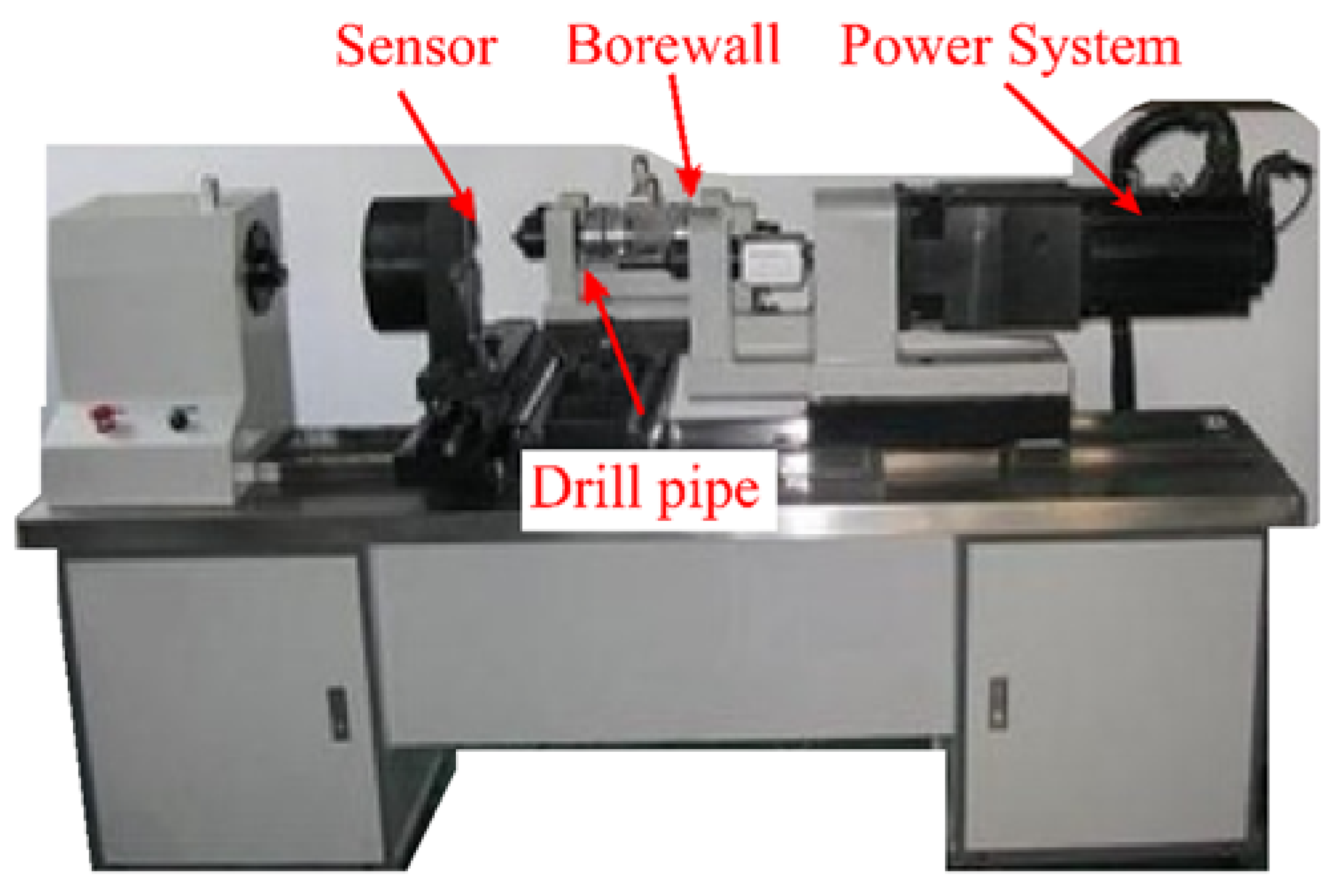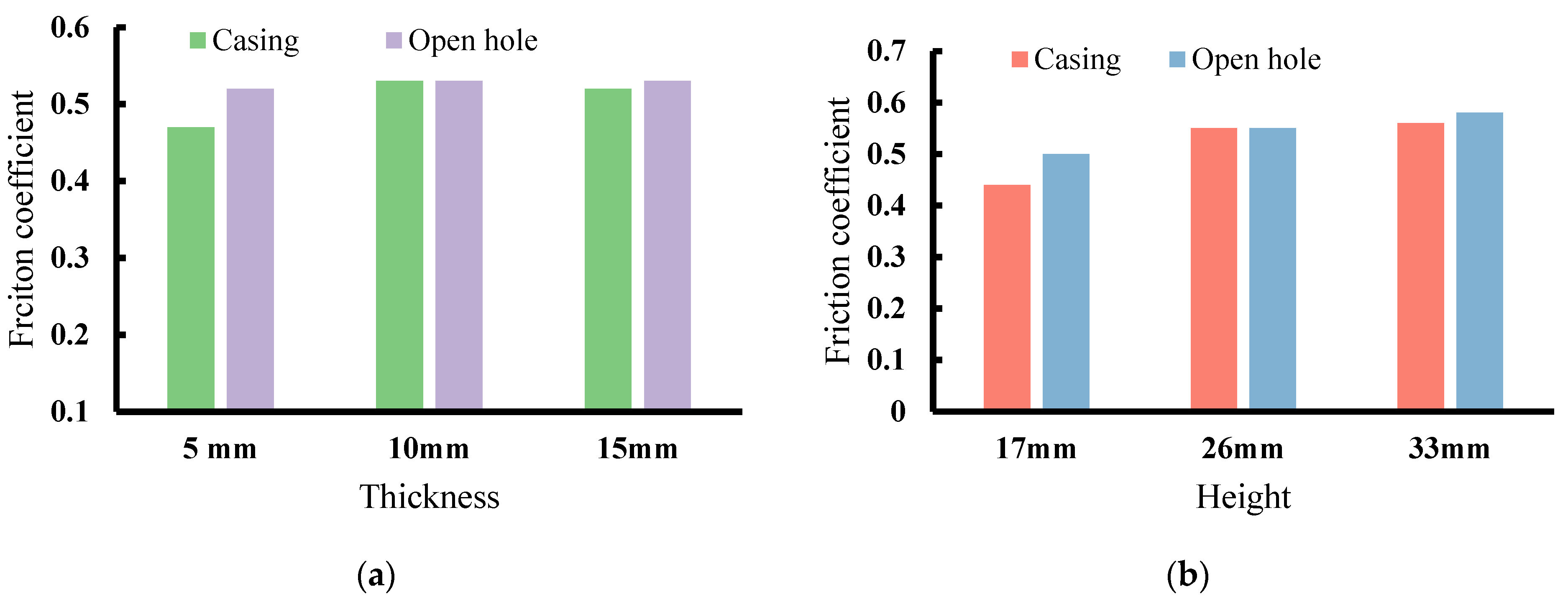Research on the Influence of a Cuttings Bed on Drill String Friction Torque in Horizontal Well Sections
Abstract
:1. Introduction
2. Materials and Methods
2.1. Experimental Plan Design
2.2. Preparation of Experimental Samples
2.3. Preparation of Open-Hole Rock Samples
2.4. Cuttings Collection and Classification
3. Results
3.1. Experimental Study on Friction Coefficient between Casing Section and Open Hole Section of Gas Drilling Horizontal Well
3.1.1. Experimental Study on the Influence of Cuttings Size and Lithology on Friction Coefficient under Open-Hole Conditions
3.1.2. Experimental Study on the Influence of Cuttings Size and Lithology on Friction Coefficient under Casing Conditions
3.2. Experimental Study on the Influence of Cuttings Deposition on the Friction Coefficient of the Horizontal Section of a Gas Drilling Horizontal Well
3.2.1. Deposition Characteristics of Cuttings in Horizontal Section and Analysis of Drill String “Coating Effect”
3.2.2. Experimental Study on the Influence of Cuttings “Coating Effect” on Friction Coefficient
4. Conclusions
Author Contributions
Funding
Acknowledgments
Conflicts of Interest
References
- Su, Z.; Gudmundsson, J.S. Perforation inflow reduces frictional pressure loss in horizontal wellbores. J. Pet. Sci. Eng. 1998, 19, 223–232. [Google Scholar] [CrossRef]
- Miller, S.F.; Tao, J.; Shih, A.J. Friction drilling of cast metals. Int. J. Mach. Tools Manuf. 2006, 46, 1526–1535. [Google Scholar] [CrossRef]
- Miller, S.F.; Shih, A.J.; Blau, P.J. Microstructural alterations associated with friction drilling of steel, aluminum and titanium. J. Mater. Eng. Perform. 2005, 14, 647–653. [Google Scholar] [CrossRef]
- Krivtsov, A.M.; Wiercigroch, M. Penetration rate prediction for percussive drilling via dry friction model. Chaos Solitons Fractals 2000, 11, 2479–2485. [Google Scholar] [CrossRef]
- Zhang, J.; Mao, B.; Roegiers, J.C. On drilling directions for optimizing horizontal well stability using a dual-porosity poroelastic approach. J. Pet. Sci. Eng. 2006, 53, 61–76. [Google Scholar] [CrossRef]
- Yan, H.T. Geotechnical sampling in deep water using a tensioned conductor pipe-casing and weighted footblock. Can. Geotech. J. 1984, 21, 92–99. [Google Scholar] [CrossRef]
- Maidla, E.E. A field method for assessing borehole friction for directional well casing. J. Pet. Sci. Eng. 1988, 1, 323–333. [Google Scholar] [CrossRef]
- Babu, D.K.; Odeh, A.S.; Al-Khalifa, A.J.; Mccann, R.C. The relation between wellblock and wellbore pressures in numerical simulation of horizontal wells. SPE Reserv. Eng. 1991, 6, 324–328. [Google Scholar] [CrossRef]
- Scheid, C.M.; Calada, L.A.; Rocha, D.C.; Aranha, P.E.; Arago, F.L. Methodology to predict friction pressure drop in drilling fluid flows. Bol. Tec. Prod. Pet. 2009, 4, 301–316. [Google Scholar]
- Hao, X.U.; Tang, H.; Zhang, X. Long lateral-section horizontal well drilling technology in Xinchang gas field. Oil Drill. Prod. Technol. 2013, 35, 10–13. [Google Scholar]
- Zhao, J.; Chen, X.; Li, Y.; Fu, B.; Xu, W. Numerical simulation of multi-stage fracturing and optimization of perforation in a horizontal well. Pet. Explor. Dev. 2017, 44, 119–126. [Google Scholar] [CrossRef]
- Tian, Z.; Shi, L.; Qiao, L. Problems in the wellbore integrity of a shale gas horizontal well and corresponding countermeasures. Nat. Gas Ind. B 2015, 2, 522–529. [Google Scholar] [CrossRef] [Green Version]
- Zhu, X.H.; Li, K.; An, J.W. Calculation and analysis of dynamic drag and torque of horizontal well strings. Nat. Gas Ind. B 2019, 6, 183–190. [Google Scholar] [CrossRef]
- Zeng, X.; Tong, D. An improvement of the design method of optimal horizontal wellbore length. Pet. Explor. Dev. 2011, 38, 216–220. [Google Scholar]
- Tian, J.; Yang, Y.; Dai, L.; Yang, L. Dynamics and anti-friction characteristics study of horizontal drill string based on new anti-friction tool. Int. J. Green Energy 2021, 18, 720–730. [Google Scholar] [CrossRef]
- Ma, T.; Chen, P. Analysis of wellbore stability for horizontal wells in stratification shale. J. Cent. South Univ. (Sci. Technol.) 2015, 46, 1375–1383. [Google Scholar]
- Gao, G.; Miska, S.Z. Effects of boundary conditions and friction on static buckling of pipe in a horizontal well. SPE J. 2009, 14, 782–796. [Google Scholar] [CrossRef]
- Mishra, B.; Berne, B.J. Hydrodynamic calculation of the frequency dependent friction on the bond of a diatomic molecule. J. Chem. Phys. 1995, 103, 1160–1174. [Google Scholar] [CrossRef]


| Cutting Particle Size | 3400–3800 | 4500–4800 |
|---|---|---|
| <l mm | 0.55 | 0.56 |
| 1 mm | 0.53 | 0.55 |
| 2 mm | 0.51 | 0.57 |
| 3 mm | 0.51 | 0.56 |
| >4 mm | 0.57 | 0.53 |
| Mixed cuttings | 0.54 | 0.52 |
| No cuttings | 0.62 | |
| Cutting Particle Size | 3400–3800 | 4500–4800 |
|---|---|---|
| <1 mm | 0.48 | 0.58 |
| 1 mm | 0.50 | 0.50 |
| 2 mm | 0.43 | 0.51 |
| 3 mm | 0.59 | 0.59 |
| >4 mm | 0.56 | 0.56 |
| Mixed cuttings | 0.60 | 0.61 |
| No cuttings | 0.79 | |
| Thickness | 5 mm | 10 mm | 15 mm |
|---|---|---|---|
| Casing | 0.47 | 0.53 | 0.52 |
| Open-hole | 0.52 | 0.53 | 0.53 |
| Height | 17 mm | 26 mm | 33 mm |
|---|---|---|---|
| Casing | 0.44 | 0.55 | 0.56 |
| Open-hole | 0.50 | 0.55 | 0.58 |
Publisher’s Note: MDPI stays neutral with regard to jurisdictional claims in published maps and institutional affiliations. |
© 2022 by the authors. Licensee MDPI, Basel, Switzerland. This article is an open access article distributed under the terms and conditions of the Creative Commons Attribution (CC BY) license (https://creativecommons.org/licenses/by/4.0/).
Share and Cite
Li, X.; Fan, Y.; Li, J.; Su, X.; Zhan, S.; Hu, G.; He, Y.; Zhang, M. Research on the Influence of a Cuttings Bed on Drill String Friction Torque in Horizontal Well Sections. Processes 2022, 10, 2061. https://doi.org/10.3390/pr10102061
Li X, Fan Y, Li J, Su X, Zhan S, Hu G, He Y, Zhang M. Research on the Influence of a Cuttings Bed on Drill String Friction Torque in Horizontal Well Sections. Processes. 2022; 10(10):2061. https://doi.org/10.3390/pr10102061
Chicago/Turabian StyleLi, Xiaoming, Yuyue Fan, Jiahua Li, Xinghua Su, Sheng Zhan, Gang Hu, Yiqing He, and Ming Zhang. 2022. "Research on the Influence of a Cuttings Bed on Drill String Friction Torque in Horizontal Well Sections" Processes 10, no. 10: 2061. https://doi.org/10.3390/pr10102061




